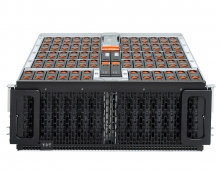
Server Market Revenue Decreased in First Quarter
Factory revenue in the worldwide server market decreased 7.7% year over year to $10.9 billion in the first quarter of 2013 (1Q13), according to IDC.
This is the fifth time in the previous six quarters that the server market has experienced a year-over-year decline in worldwide revenue. Server unit shipments decreased 3.9% year over year in 1Q13 to 1.9 million units as consolidation continued to be a strategic focus for many large and small customers around the globe, IDC said.
HP held the number 1 position in the worldwide server market with 26.9% factory revenue share for 1Q13. HP's 14.8% revenue decline included weak demand for x86-based ProLiant servers, which were challenged by competitive pricing pressure, and continued weakness in Itanium-based Integrity server revenue.
IBM held the number 2 spot with 25.5% share for the quarter as factory revenue decreased 13.4% compared to 1Q12. Demand for IBM's Power Systems and x86-based System x servers declined year over year while demand for System z improved solidly in the quarter due to the combined effects of a weak year-over-year compare and the continuation of a refresh cycle.
Dell maintained the third position with 18.5% factory revenue market share in 1Q13 as factory revenue increased 10.1% compared to 1Q12. Dell gained 3.0 points of worldwide server market share in the quarter, helped in part by strong demand from their density optimized datacenter solutions business.
Fujitsu, Oracle, and Cisco ended the quarter in a three-way statistical tie for the number 4 position with 5.1%, 4.8%, and 4.1% factory revenue share respectively. Fujitsu's 1Q13 factory revenue decreased 8.5% compared to 1Q12 and Oracle experienced a 26.2% year-over-year decline in factory revenue in 1Q13. Cisco's factory revenue was up 34.9% year over year in 1Q13.
Top 5 Corporate Family, Worldwide Server Systems Factory Revenue, First Quarter of 2013 (Revenues are in Millions)
Vendor |
1Q13 Revenue |
1Q13 Market Share |
1Q12 Revenue |
1Q12 Market Share |
1Q13/1Q12 Revenue Growth |
1. HP |
$2,947 |
26.9% |
$3,460 |
29.2% |
-14.8% |
2. IBM |
$2,793 |
25.5% |
$3,224 |
27.2% |
-13.4% |
3. Dell |
$2,028 |
18.5% |
$1,842 |
15.5% |
10.1% |
4. Fujitsu |
$562 |
5.1% |
$614 |
5.2% |
-8.5% |
4. Oracle |
$528 |
4.8% |
$716 |
6.0% |
-26.2% |
4. Cisco |
$450 |
4.1% |
$334 |
2.8% |
34.9% |
Others |
$1,655 |
14.0% |
$1,627 |
14.9% |
-1.7% |
All Vendors |
$10,936 |
100% |
$11,846 |
100% |
-7.7% |
Source: IDC's Worldwide Quarterly Server Tracker, May 2013
IDC also found that Linux server demand was positively impacted by high performance computing (HPC) and cloud infrastructure deployments, as hardware revenue improved 3.4% year over year in 1Q13 to $2.5 billion. Linux servers now represent 23.1% of all server revenue, up 2.5 points when compared with the first quarter of 2012.
Microsoft Windows server hardware revenue declined 4.2% year over year in 1Q13 with quarterly server hardware revenue totaling $5.7 billion representing 52.2% of overall quarterly factory revenue, up 1.9 points over the prior year's quarter.
Unix servers experienced a revenue decline of 35.9% year over year to $1.4 billion representing 12.6% of quarterly server revenue. This was the seventh consecutive quarter of revenue decline in the Unix server market and all major Unix server vendors experienced a year-over-year revenue decline in the quarter when compared with the first quarter of 2012.
IBM's System z mainframe running z/OS experienced its second consecutive quarter of growth, increasing revenue 7.0% year over year to $0.8 billion, representing 7.7% of all server revenue in 1Q13.
"The non-x86 server market is being reshaped by a new pattern of market dynamics in which RISC architectures are being used for hyper-scale Web and HPC deployments and mainframes are being used to build 3rd platform private clouds," said Kuba Stolarski, Research Manager, Enterprise Servers at IDC. "Non-x86 architectures are about to scale out in a big way, as the lines between x86 and non-x86 workloads are blurring. In an interesting turn of events, customers are increasingly considering x86 servers for mission critical and other traditional scale-up solutions and non-x86 servers for innovative, cost-effective, and integrated solutions for analytics, cloud, mobile, and social platforms."
There are two types of modular form factors, each with a distinct use case. Blade servers, which are highly leveraged in enterprise's virtualized environments, declined 2.9% year over year to $1.9 billion. Blades now account for 17.7% of total server revenue. HP maintained the number 1 spot in the blade server market in 1Q13 with 44.6% revenue share; Cisco and IBM shared* the second position in the blade market with 17.6% and 17.2% revenue share, respectively.
Density Optimized servers, utilized by large heterogeneous datacenters, experienced very strong demand in 1Q13. Revenue grew 54.8% year over year in 1Q13 to $753 million as unit shipments increased 39.3% to just under 215,000 servers. Density Optimized servers now represent 6.9% of all server revenue and 11.2% of all server shipments. Dell maintained the number 1 spot in the Density Optimized segment in 1Q13 with 47.3% revenue share.
Demand for x86 servers weakened in 1Q13 with revenues decreasing 1.7% year over year in the quarter to $8.3 billion worldwide as unit shipments declined 3.4% to 1.9 million servers. HP led the market with 31.6% revenue share based on 11.6% revenue decline over 1Q12. Dell retained second place, securing 24.3% revenue share, while IBM now holds 14.1% revenue share. Overall, this was the fifteenth quarter out of the previous sixteen quarters with year-over-year increases in average selling prices for x86 servers as both the mix of systems and average system configurations continue to move up-market to serve customer virtualization needs and driving generally higher product margin for x86 ecosystem players. This was the second consecutive quarter of a year-over-year shipment decline for x86 servers as small and large enterprises aggressively consolidate their computing needs.





















